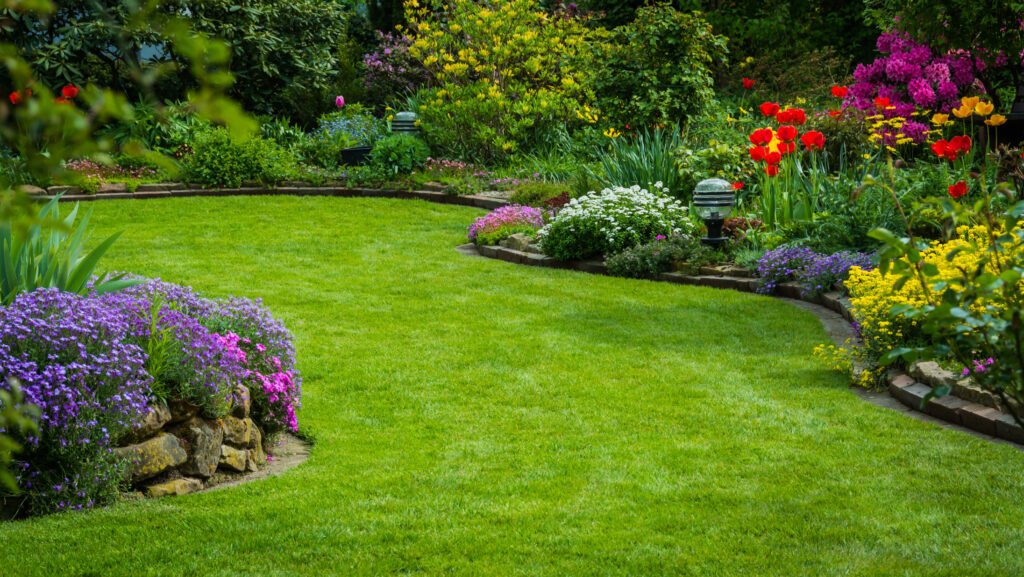Creating a lush and healthy lawn is an all-year endeavour that requires patience, planning, and a bit of know-how. Each season brings its tasks, from fertilizing and aerating to weeding and mowing.
In the following sections, you’ll discover tailored tips that will guide you through the proper care and maintenance of your lawn, ensuring it remains vibrant and inviting every month of the year.
Whether you’re a seasoned gardener skilled with electric lawnmowers or a beginner passionate about outdoor spaces, these guidelines will help you cultivate a thriving backyard oasis.

Spring: Time for Revival and Growth
The arrival of spring is a welcome sign for both gardeners and plants alike. It’s the perfect time to revive your lawn after the dormant winter months and set the stage for healthy growth in the upcoming seasons.
Aerate Your Lawn
One of the first tasks to tackle in spring is aerating your lawn. This process involves poking small holes in the soil to allow better air, water, and nutrient circulation to the roots. It also helps loosen compacted soil and promotes healthy root growth.
You can use a manual or motorized aerator, depending on the size of your lawn. Pay special attention to areas with heavy foot traffic or where water pools.
Fertilize for Strong Roots
Spring is the ideal time to fertilize your lawn, as plants are waking up from their winter slumber and need nutrients to support growth. Look for a fertilizer with a balanced ratio of nitrogen, phosphorus, and potassium (NPK) to promote overall health.
Avoid using too much fertilizer, and follow package instructions carefully. Too much nitrogen can lead to excessive leaf growth, making your lawn susceptible to diseases and pests.
Mow Regularly
As the temperatures start to rise, your grass will also begin growing at a faster pace. It’s essential to keep up with regular mowing throughout spring, ensuring not to cut off more than one-third of the grass blade at a time. This practice prevents stress on the plants and encourages thick, healthy growth.
Remember to sharpen your mower blades regularly for a clean cut, and leave the grass clippings on the lawn as they act as a natural fertilizer.
Weed Control
Spring is also the perfect time to tackle pesky weeds before they have a chance to take over your lawn. Pull out any visible weeds by hand or use an herbicide specifically designed for lawns. If you opt for an herbicide, follow instructions carefully and avoid using it on windy days.
Summer: Maintaining A Healthy Lawn
Summer brings longer days, warmer temperatures, and more time spent outdoors. It’s also the season when your lawn will need extra care to withstand heatwaves and dry spells.
Deep Watering
Your lawn needs about an inch of water each week to stay healthy during the hot summer months. It’s better to give your lawn a deep watering once or twice a week rather than frequent shallow watering. Deep watering encourages deeper root growth, making your lawn more resilient to droughts.
Water in the early morning hours to reduce evaporation and prevent fungal diseases from developing.
Mowing Tips
As the weather heats up, you may need to raise your mower blades to leave the grass a bit longer. Taller grass provides more shade for the soil, reducing water evaporation and helping to keep it cool.
If possible, avoid mowing during the hottest part of the day, as this can stress your lawn. Also, remember not to remove more than one-third of the grass blade at a time.
Keep an Eye Out for Pests
Summer is prime time for pests and diseases to invade your lawn. Keep an eye out for signs of damage, such as brown patches or chewed leaves. If you notice any issues, act quickly to prevent them from spreading.
Make sure to keep your lawn well-maintained and free of debris, and avoid keeping standing water as it attracts pests.
Fall: Preparing for the Cold
As the days start getting shorter and temperatures begin to drop, it’s time to prepare your lawn for winter. The goal is to help your grass survive the dormant season and come out strong in spring.
Fertilize Again
Just like in spring, fall is the perfect time to fertilize your lawn. Look for a fertilizer with higher potassium levels to promote root growth and improve winter hardiness.
Avoid using weed and feed products as they can harm newly seeded lawns or young plants.
Rake Those Leaves
While it may be tempting to leave fallen leaves on your lawn, it’s essential to rake them regularly. Thick layers of leaves block sunlight and trap moisture, creating an ideal environment for disease and pest development.
If you have a mulching mower, you can also shred the leaves into small pieces and leave them on the lawn as a natural fertilizer.
Aerate Again
Fall is also an excellent time to aerate your lawn again, especially if it’s been heavily used during summer. This process helps to reduce soil compaction and allows for better air and water circulation, promoting healthy root growth.
Keep Mowing
As the temperatures start to drop, your grass will grow at a slower pace. Continue mowing regularly, but gradually lower the height of the mower blades until your last cut before winter.
Winter: Preparing for Next Spring
Winter is the season when your lawn goes into dormancy, but that doesn’t mean you can forget about it entirely. Winter lawn care isn’t too demanding, but there are a few steps for you to take.
Keep Off the Grass
Avoid walking on your lawn as much as possible during winter. The weight of foot traffic can damage frozen grass blades and lead to thin or patchy areas come spring.
Remove Snow Properly
If you live in an area with heavy snowfall, make sure to shovel or plow carefully. Avoid piling up snow on your lawn, which can suffocate the grass and promote mold growth. Also, be careful when using salt or ice melt products, as they can damage your lawn.
Winter Watering
If you live in an area with mild winters, you may need to water your lawn occasionally. Make sure to water only when temperatures are above freezing and water early in the day so that the moisture has time to absorb before the temperature drops at night.
Late Winter Fertilization
In late winter, you can apply a slow-release fertilizer to help your lawn prepare for spring. This practice gives your grass a head start once the temperatures rise, promoting healthy growth and vibrant green color.
Remember to follow package instructions carefully and avoid fertilizing on frozen ground or before a snowfall, as it can wash away the nutrients.
Conclusion
Maintaining a healthy lawn throughout the year requires dedication and proper care. By following these seasonal lawn care tips, you can ensure your grass stays lush and green all year round. Remember to adjust your lawn care routine based on your region’s climate and your grass type for optimal results. So go out there and enjoy your beautiful, well-cared-for lawn!











Leave a Reply